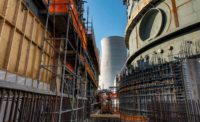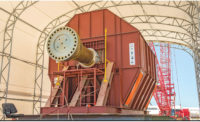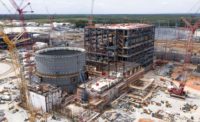Viewpoint: The American Energy Infrastructure
What Went Wrong on the Westinghouse Nuclear Projects
The data missing in ENR's coverage is key to how to fix nuclear power plant work

Work at the V.C. Summer nuclear power project in December 2015.
Courtesy of SCANA
Doing anything right the first time is tough. Doing it right the first time and achieving excellence is even tougher. As Westinghouse and other companies involved in building the V.C. Summer 2 and 3 and Vogtle Electric Generating Plant 3 and 4 nuclear power projects in South Carolina and Georgia decide whether to stop work or finish, we still haven't been told the most important information about these troubled projects: the percentage of engineering design done to date and the schedule for finishing that work.
The answer is important not just to the future of Westinghouse, which has filed for bankruptcy protection; its parent company, Toshiba; and the ratepayers in South Carolina and Georgia. The answer is important to the future of nuclear power plant construction in the U.S.
To build a first-of-its kind reactor without huge delays and overruns would have been extraordinary for an experienced engineer-procure-construct contractor, never mind an inexperienced original equipment manufacturer that began with a low level of engineering completion when the contract was signed.
ENR's coverage until now has focused on the construction schedule, but that is misguided. Although the engineering completion information is contractually private, unreported and not obvious, it is critical to understanding the root causes of the project overruns and delays that have devastated Westinghouse and sent shock waves through the nuclear construction world.
Westinghouse, in joint venture with Shaw, sold four modular-construction AP1000 nuclear plants in 2008 on the basis of the structure and system designs that, at the time, were in a low-double-digit percentage of completion. Both purchasing utilities reviewed the contractors' estimates with outside experts.
To find the answer to what has plagued these projects, I suggest looking into many different aspects of the work, including program, cost, time and quality management. I also suggest investigating contract administration, safety and sustainability in planning and predesign, design, procurements, construction and operations (including maintenance and sustainability).
But the biggest question is whether Westinghouse, not having experience as an EPC deliverer, even knows its major errors!
I submit that unless Westinghouse and the project teams have maintained a 3D CADD electronic platform that integrates all the statused phases of the nuclear plant design, Westinghouse cannot have managed its projects correctly. There is no one entity that can manage such an extremely regulated, complex design without an early commitment to using such a system and without an experienced staff. As Bechtel construction manager J.O. Stull has said, "More important than any plan is the organizations' people's understanding, commitment and follow-through."
Long ago, the American Association of Cost Engineers developed a design-attributes completion matrix to determine the contingency percentage necessary for finishing nuclear power and other types of projects. Others, such as the Construction Industry Institute, studied contingency and risk issues on complex project cases to incorporate templates for managing the project risk profile probabilities and impacts.
If ENR really wants to get to the bottom of what happened, it must find out what the percent engineered to date is now. ENR should also try to learn the major management errors in the total project schedule in each phase. Beyond these questions, a deep analysis is unnecessary. Why? Because one need only look at the basis of the project's five-year planned schedule.
Assumptions About the Nuclear Construction
I'm making several assumptions about what happened on these projects.
The first is that the project team lacked an early commitment for a 3D CADD model to integrate all in-house and outsourced design and procurements. Such a model would have enhanced constructability by elimination of interferences and help with accessibility verification, construction sequence planning, material takeoffs, piping isometrics and all permanent and temporary site engineering.
The next assumption is that there was too little modular design and less than 95% fabrication completion status (steel and internal partial systems and components) upon shipment before construction, which the five-year plant schedule depends on.
Finally, I'm assuming that the project team failed to perform early co-location of all EPC major sub-EPC management and Vendor management, including early input into the planning and predesign process. This type of failure was behind the last German/French Airbus fiasco. Remember that one?
The AP1000 project is another example of the general historical incompetence of OEM suppliers, which have all tried bringing to market a first-of-a-kind nuclear design and becoming "first time" A/EPCs. This new series of OEM nuclear plant EPC failures looks like what many OEMs and their clients experienced in the 1960s and 1970s. Later in the work, non-OEM engineer-contractors were brought in, on a reimbursable basis, to finish one-of-a-kind designs and construction. Because of their late arrival, there were just a few near-success standard designs; e.g., Bechtel's Standard Nuclear Unit Power Plant System (SNUPPS). In use before the arrival of CADD, SNUPPS used a scale model built in the Bechtel basement to plan and find constructability issues. Devised by J.O. Stull, it tracked parts of the project and its systems and components with alphanumeric identifiers. Photos were taken when issues were discovered and discussed with engineering staff. By the time SNUPPS arrived, however, demand for power had slipped so there was no need to risk using it.
The First-Time EPC Performer
Why would or could a capable OEM component and nuclear services manufacturer be a successful first-time EPC performer on a new nuclear project site? We know Westinghouse did not begin to use a 3D platform nor a building information modeling system to collect the billions of parts and pieces of detailed information into one integrated design; nor did it have any electronic ties into a platform with the myriad of unmanaged overseas design shops.
Later, as I understand it, Westinghouse's 2D approach was supplanted with a 3D model, but it just became a design "clash" information model. Westinghouse may never have understood that a modular steel design had to be "done/done" internally with all systems and components and triple engineered for rigging for loading, shipping, transport, off-load and final rigging to location in order to be built in their promised five-year time frame. The company should have understood that because it did not happen for China's Sanmen Nuclear Power Station, another Westinghouse AP1000 pressurized water reactor project. It broke ground in 2008 and, after delays, is scheduled to begin operation this year.
General Dynamics understood the modular concept in 2006 when it fought off the U.S. Navy to freeze its Virginia Class submarine design of its Electric Boat submarine. That allowed General Dynamics to win more work by beating down costs for more reproductions. Kiewit Offshore Systems would understand this in performing its new order for Israeli oil field platforms delivery!
Further, none of the Westinghouse designs used a universal system of knowledge, material and equipment identifiers. It is essential to use Plant Building/Level/Area and alphanumeric system/class/code identifications for structures, systems and components. Bechtel uses these identifications in its designs for standard work processes and procedures (SWPPs), and they are essential. A foreman in the field needs to know that BLA is the area code for the material in the power block. The alphanumeric identifier tells the foremen in what system it belongs when the foremen look for it in the laydown area or warehouse storage units.
 |
| Edward Shyloski |
Construction people know all plant systems are designed geometrically but are constructed horizontally, elevation by elevation. Chiyoda, a Japanese premier oil and gas EPC company, uses a total approach to work that is based on a alphanumeric system of structures, systems and components and color-coding status on its 3D CADD platforms.
On its gas field in Qatar, Chiyoda employees since the early 2000s have input and monitored the EPC status on large screens as well as on individual computers that status the construction schedule once each day in the model. The model update reflects a determinant of progress based on standard programmed apportionments for installed and inspected stages connected to each phase of completion of structures, systems and components.
Not all of commercial nuclear construction history is bad; there have been a few great nuclear plant success stories. Japan's Sheka 2 was built in a record time of 41 months not only because it was a highly modularized nuclear design replication. Most importantly, it had 165 totally completed modules sitting on the excavation's embankment waiting for the basemat concrete placement. Florida Power & Light's St. Lucie executive, Bill Derrickson, finished Unit 2 on Hutchinson Island in 60 months because he had a nearly completed design and a resident team located across the street from the Nuclear Regulatory Commission, where the team was busy solving problems.
ENR is not telling the real story in its reporting about the Westinghouse projects in South Carolina and Georgia, or about what really is the problem with late AP1000 construction. Construction is not the real single issue holding up the work—it just appears that way and so that is generally what's in the headlines. Unless the media find out, we'll never know the truth.
Edward C. Shyloski Jr., now retired, is a licensed engineer who has been a vice president at Bechtel, Shaw Group and Stone & Webster. His career includes nuclear power and major infrastructure projects in the U.S. and overseas. He can be reached at shyloconsulting@gmail.com.



